Tobias A. Eriksson
Implementing Neural Network-Based Equalizers in a Coherent Optical Transmission System Using Field-Programmable Gate Arrays
Dec 09, 2022Abstract:In this work, we demonstrate the offline FPGA realization of both recurrent and feedforward neural network (NN)-based equalizers for nonlinearity compensation in coherent optical transmission systems. First, we present a realization pipeline showing the conversion of the models from Python libraries to the FPGA chip synthesis and implementation. Then, we review the main alternatives for the hardware implementation of nonlinear activation functions. The main results are divided into three parts: a performance comparison, an analysis of how activation functions are implemented, and a report on the complexity of the hardware. The performance in Q-factor is presented for the cases of bidirectional long-short-term memory coupled with convolutional NN (biLSTM + CNN) equalizer, CNN equalizer, and standard 1-StpS digital back-propagation (DBP) for the simulation and experiment propagation of a single channel dual-polarization (SC-DP) 16QAM at 34 GBd along 17x70km of LEAF. The biLSTM+CNN equalizer provides a similar result to DBP and a 1.7 dB Q-factor gain compared with the chromatic dispersion compensation baseline in the experimental dataset. After that, we assess the Q-factor and the impact of hardware utilization when approximating the activation functions of NN using Taylor series, piecewise linear, and look-up table (LUT) approximations. We also show how to mitigate the approximation errors with extra training and provide some insights into possible gradient problems in the LUT approximation. Finally, to evaluate the complexity of hardware implementation to achieve 400G throughput, fixed-point NN-based equalizers with approximated activation functions are developed and implemented in an FPGA.
Towards FPGA Implementation of Neural Network-Based Nonlinearity Mitigation Equalizers in Coherent Optical Transmission Systems
Jun 24, 2022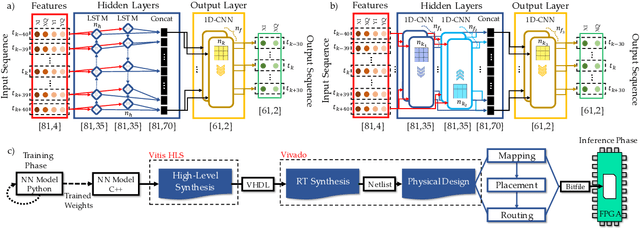
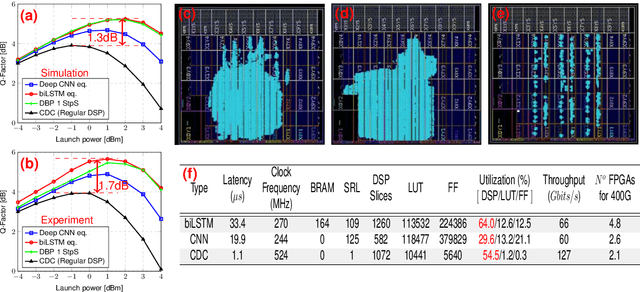
Abstract:For the first time, recurrent and feedforward neural network-based equalizers for nonlinearity compensation are implemented in an FPGA, with a level of complexity comparable to that of a dispersion equalizer. We demonstrate that the NN-based equalizers can outperform a 1 step-per-span DBP.
Geometric Constellation Shaping for Fiber Optic Communication Systems via End-to-end Learning
Oct 01, 2018


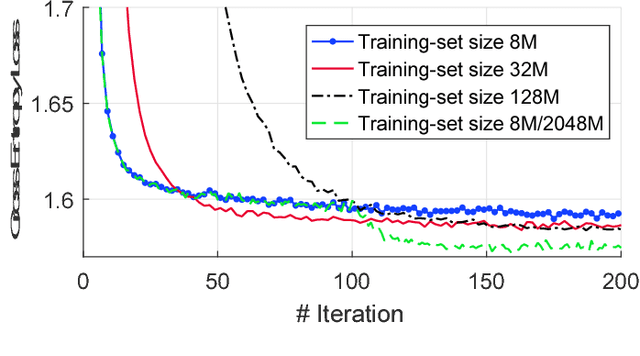
Abstract:In this paper, an unsupervised machine learning method for geometric constellation shaping is investigated. By embedding a differentiable fiber channel model within two neural networks, the learning algorithm is optimizing for a geometric constellation shape. The learned constellations yield improved performance to state-of-the-art geometrically shaped constellations, and include an implicit trade-off between amplification noise and nonlinear effects. Further, the method allows joint optimization of system parameters, such as the optimal launch power, simultaneously with the constellation shape. An experimental demonstration validates the findings. Improved performances are reported, up to 0.13 bit/4D in simulation and experimentally up to 0.12 bit/4D.
End-to-end Deep Learning of Optical Fiber Communications
Aug 03, 2018



Abstract:In this paper, we implement an optical fiber communication system as an end-to-end deep neural network, including the complete chain of transmitter, channel model, and receiver. This approach enables the optimization of the transceiver in a single end-to-end process. We illustrate the benefits of this method by applying it to intensity modulation/direct detection (IM/DD) systems and show that we can achieve bit error rates below the 6.7\% hard-decision forward error correction (HD-FEC) threshold. We model all componentry of the transmitter and receiver, as well as the fiber channel, and apply deep learning to find transmitter and receiver configurations minimizing the symbol error rate. We propose and verify in simulations a training method that yields robust and flexible transceivers that allow---without reconfiguration---reliable transmission over a large range of link dispersions. The results from end-to-end deep learning are successfully verified for the first time in an experiment. In particular, we achieve information rates of 42\,Gb/s below the HD-FEC threshold at distances beyond 40\,km. We find that our results outperform conventional IM/DD solutions based on 2 and 4 level pulse amplitude modulation (PAM2/PAM4) with feedforward equalization (FFE) at the receiver. Our study is the first step towards end-to-end deep learning-based optimization of optical fiber communication systems.
Deep Learning of Geometric Constellation Shaping including Fiber Nonlinearities
May 10, 2018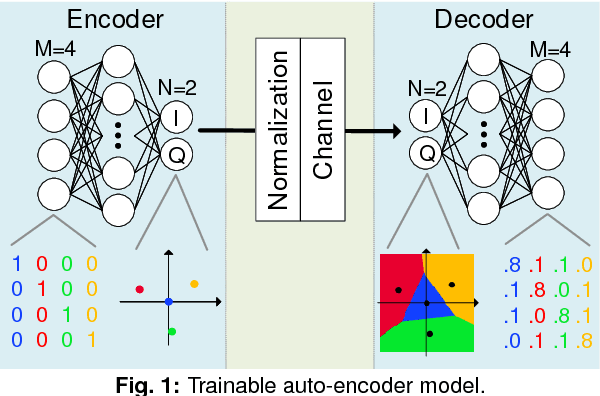

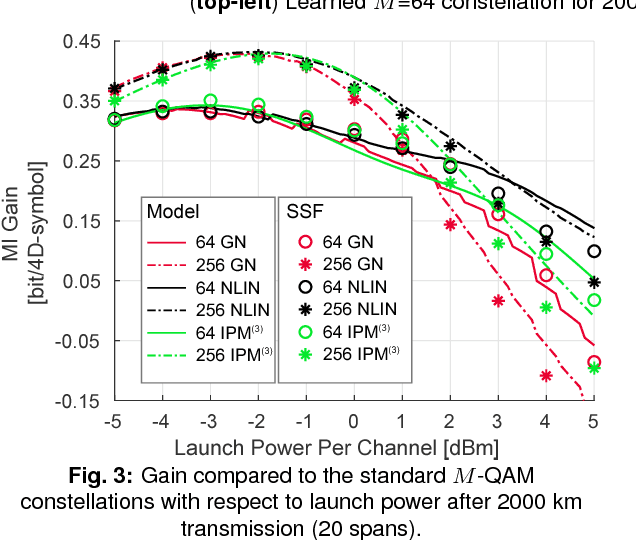

Abstract:A new geometric shaping method is proposed, leveraging unsupervised machine learning to optimize the constellation design. The learned constellation mitigates nonlinear effects with gains up to 0.13 bit/4D when trained with a simplified fiber channel model.
 Add to Chrome
Add to Chrome Add to Firefox
Add to Firefox Add to Edge
Add to Edge